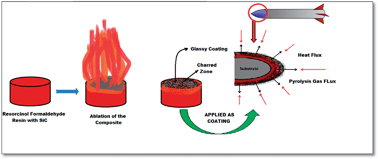Novel hybrid ablative composites of resorcinol formaldehyde as thermal protection systems for re-entry vehicles
Abstract
Numerous disasters of re-entry vehicles because of high kinetic and frictional forces have paved the way for the enhancement of thermal protection systems (TPS). These TPS protect the structures and payloads of re-entry probes during hypersonic flight from space to a planetary atmosphere, and insulate the surface by sacrificial pyrolysis and concomitant formation of tough refractory char over the surface of the insulator. The present perspective demonstrates the development of a novel hybrid composite of resorcinol formaldehyde with an ultra high temperature ceramic (UHTC), silicon carbide, aiming at fulfilling the thermal requirements of ablation resistant composite coatings with improved tenacity and adhesion to the substrate. These composites were synthesized via an in situ polymerization, which ensures molecular level dispersion. The ablation resistance with respect to mass loss was quantified by testing under an oxyacetylene flame up to 2300 °C for 60 s, which imitates the conditions of re-entry systems, notably reducing the mass ablation rate and linear ablation rates by 44 and 76%, respectively. The improved ablation resistance of SiC–RF can be attributed to the formation of glassy, fused nano silica upon its thermal oxidation, and effectively blocks oxygen from attacking the matrix. X-ray diffraction studies reveal and confirm the formation of SiO2, which protectively cover the surface and peaks at 24° and 44° attributing to (002) and (100), respectively, for turbostratic carbon formed during pyrolysis. FESEM imaging was employed to study surface topography, which confirms the same and reveals fused structures on carbonized surfaces and EDAX, quantitatively substantiating the presence of silica. TGA measurements, consummated up to 800 °C, show that the incorporation of well-dispersed SiC results in an increase in char residues up to 23% with respect to pristine RF, and a consistent improvement in thermal stability with an increase in concentration is evident. The results prove that the incorporation of silicon carbide exhibits positive effects on improving the ablation resistance and thermal properties of the RF resin by promoting the formation of fused nano silica structures on the surface.


 Please wait while we load your content...
Please wait while we load your content...